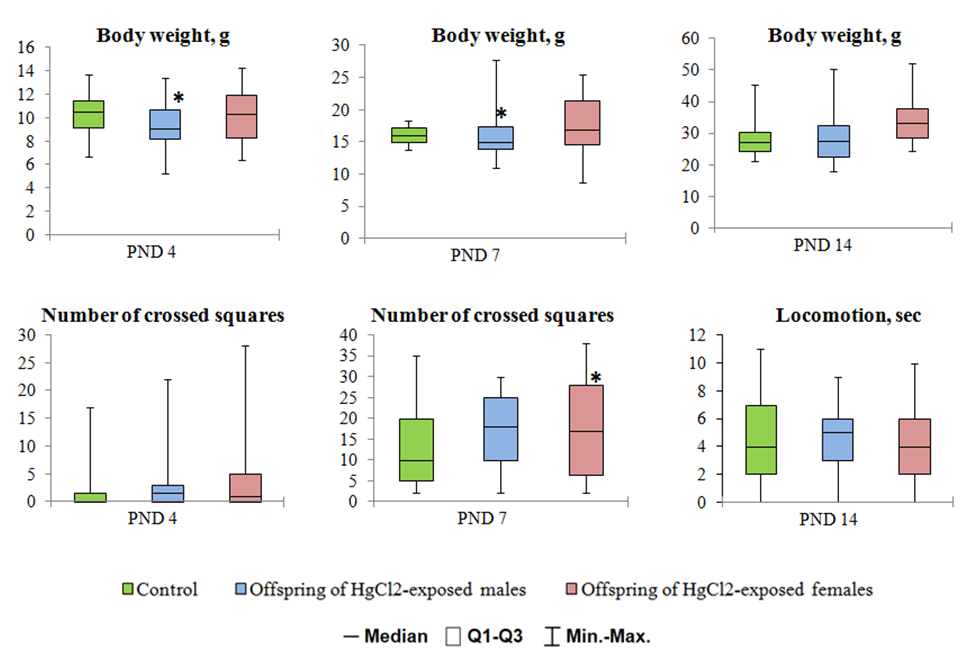1. Kumar V, Umesh M, Shanmugam MK, Chakraborty P, Duhan L, Gummadi SN, et al. A Retrospection on Mercury Contamination, Bioaccumulation, and Toxicity in Diverse Environments: Current Insights and Future Prospects. Sustainability. 2023;15(18). [
DOI:10.3390/su151813292]
2. Arefieva A, Barigina V, Zatsepina O. The present-day ideas about impact of mercuric compounds at cell and system levels. Ekologiia Cheloveka. 2010(8):35.
3. Bezgodov I, Laptev I, Rogaleva V, Efimova N, Andreeva O. Mercury danger assessment at the enterprises of chemical industry in Irkutsk region. Bull VSNC SO RAMN. 2005;40:70-4.
4. Efimova NV, Koval PV, Rukavishnikov VS, Bezgodov IV. Problems associated with mercury pollution of environmental objects. Acta Biomedica Scientifica. 2005;1(39):127-33.
5. Anwar WA, Gabal MS. Cytogenetic study in workers occupationally exposed to mercury fulminate. Mutagenesis. 1991;6(3):189-92. [
DOI:10.1093/mutage/6.3.189] [
PMID]
6. Lamperti AA, Printz RH. Localization, accumulation, and toxic effects of mercuric chloride on the reproductive axis of the female hamster. Biol Reprod. 1974;11(2):180-6. [
DOI:10.1095/biolreprod11.2.180] [
PMID]
7. Schurz F, Sabater-Vilar M, Fink-Gremmels J. Mutagenicity of mercury chloride and mechanisms of cellular defence: the role of metal-binding proteins. Mutagenesis. 2000;15(6):525-30. [
DOI:10.1093/mutage/15.6.525] [
PMID]
8. Bonacker D, Stoiber T, Wang M, Bohm KJ, Prots I, Unger E, et al. Genotoxicity of inorganic mercury salts based on disturbed microtubule function. Arch Toxicol. 2004;78(10):575-83. [
DOI:10.1007/s00204-004-0578-8] [
PMID]
9. Zasukhina GD, Vasilyeva IM, Sdirkova NI, Krasovsky GN, Vasyukovich L, Kenesariev UI, et al. Mutagenic effect of thallium and mercury salts on rodent cells with different repair activities. Mutat Res. 1983;124(2):163-73. [
DOI:10.1016/0165-1218(83)90176-3] [
PMID]
10. Schuurs AH. Reproductive toxicity of occupational mercury. A review of the literature. J Dent. 1999;27(4):249-56. [
DOI:10.1016/S0300-5712(97)00039-0] [
PMID]
11. Lamperti AA, Printz RH. Effects of mercuric chloride on the reproductive cycle of the female hamster. Biol Reprod. 1973;8(3):378-87. [
DOI:10.1093/biolreprod/8.3.378] [
PMID]
12. Koli S, Prakash A, Choudhury S, Mandil R, Garg SK. Calcium Channels, Rho-Kinase, Protein Kinase-C, and Phospholipase-C Pathways Mediate Mercury Chloride-Induced Myometrial Contractions in Rats. Biol Trace Elem Res. 2019;187(2):418-24. [
DOI:10.1007/s12011-018-1379-x] [
PMID]
13. Merlo E, Schereider IRG, Simoes MR, Vassallo DV, Graceli JB. Mercury leads to features of polycystic ovary syndrome in rats. Toxicol Lett. 2019;312:45-54. [
DOI:10.1016/j.toxlet.2019.05.006] [
PMID]
14. Martinez CS, Escobar AG, Torres JG, Brum DS, Santos FW, Alonso MJ, et al. Chronic exposure to low doses of mercury impairs sperm quality and induces oxidative stress in rats. J Toxicol Environ Health A. 2014;77(1-3):143-54. [
DOI:10.1080/15287394.2014.867202] [
PMID]
15. Adelakun SA, Ukwenya VO, Akingbade GT, Omotoso OD, Aniah JA. Interventions of aqueous extract of Solanum melongena fruits (garden eggs) on mercury chloride induced testicular toxicity in adult male Wistar rats. Biomed J. 2020;43(2):174-82. [
DOI:10.1016/j.bj.2019.07.004] [
PMID] [
]
16. Almeer RS, Albasher G, Kassab RB, Ibrahim SR, Alotibi F, Alarifi S, et al. Ziziphus spina-christi leaf extract attenuates mercury chloride-induced testicular dysfunction in rats. Environ Sci Pollut Res Int. 2020;27(3):3401-12. [
DOI:10.1007/s11356-019-07237-w] [
PMID]
17. Kalender S, Uzun FG, Demir F, Uzunhisarcikli M, Aslanturk A. Mercuric chloride-induced testicular toxicity in rats and the protective role of sodium selenite and vitamin E. Food Chem Toxicol. 2013;55:456-62. [
DOI:10.1016/j.fct.2013.01.024] [
PMID]
18. Wong EW, Cheng CY. Impacts of environmental toxicants on male reproductive dysfunction. Trends Pharmacol Sci. 2011;32(5):290-9. [
DOI:10.1016/j.tips.2011.01.001] [
PMID] [
]
19. Pino-Lopez M, Romero-Ayuso DM. [Parental occupational exposures and autism spectrum disorder in children]. Rev Esp Salud Publica. 2013;87(1):73-85. [
DOI:10.4321/S1135-57272013000100008] [
PMID]
20. Desrosiers TA, Herring AH, Shapira SK, Hooiveld M, Luben TJ, Herdt-Losavio ML, et al. Paternal occupation and birth defects: findings from the National Birth Defects Prevention Study. Occup Environ Med. 2012;69(8):534-42. [
DOI:10.1136/oemed-2011-100372] [
PMID] [
]
21. Khera KS. Reproductive capability of male rats and mice treated with methyl mercury. Toxicol Appl Pharmacol. 1973;24(2):167-77. [
DOI:10.1016/0041-008X(73)90136-1] [
PMID]
22. Burbacher TM, Mohamed MK, Mottett NK. Methylmercury effects on reproduction and offspring size at birth. Reprod Toxicol. 1987;1(4):267-78. [
DOI:10.1016/0890-6238(87)90018-9] [
PMID]
23. Huang CF, Liu SH, Hsu CJ, Lin-Shiau SY. Neurotoxicological effects of low-dose methylmercury and mercuric chloride in developing offspring mice. Toxicol Lett. 2011;201(3):196-204. [
DOI:10.1016/j.toxlet.2010.12.016] [
PMID]
24. Szasz A, Barna B, Gajda Z, Galbacs G, Kirsch-Volders M, Szente M. Effects of continuous low-dose exposure to organic and inorganic mercury during development on epileptogenicity in rats. Neurotoxicology. 2002;23(2):197-206. [
DOI:10.1016/S0161-813X(02)00022-0] [
PMID]













































